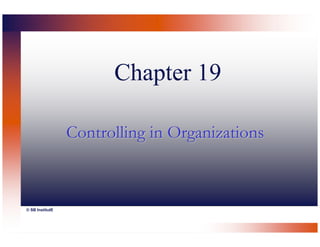More Related Content
Similar to Ch19 Controlling in Organisation
Similar to Ch19 Controlling in Organisation (20)
More from Dr. C.V. Suresh Babu
More from Dr. C.V. Suresh Babu (20)
Ch19 Controlling in Organisation
- 1. Chapter 19
Controlling in Organizations
© SB InstitutE
- 2. 19.1
Learning Objectives
After reading this chapter, you should be able to:
• Explain the foundations of control
• Discuss ways that organizations can create effective controls
• Identify the six phases of the corrective control model
• Describe the primary methods of organizational control
© SB InstitutE
- 3. 19.2
Preventive and Corrective Controls
Preventive Reduce Minimize Need
Errors for Corrective
Controls Action
Corrective Reduce or Achieve
Eliminate Conformity with
Controls Unwanted Organization’s
Behaviors or Regulations
Results and Standards
© SB InstitutE
- 4. 19.3
Examples of Different Sources and Types of Control
Type of Control
Source of Control Preventive Corrective
Stakeholders Maintaining quotas for Changing recruitment
hiring personnel in policies to attract
protected classes qualified personnel
Organization
Using budgets to Disciplining an
guide expenditures employee for violating
a “No Smoking” safety
regulation in a
hazardous area
© SB InstitutE
Adapted from Table 19.1
- 5. 19.4
Examples of Different Sources and Types of Control (cont.)
Type of Control
Source of Control Preventive Corrective
Group Advising a new Harassing and socially
employee about the isolating a worker who
group’s productivity norm doesn’t conform to
group norms
Deciding to skip lunch
in order to complete
Individual a project on time Revising a report you
have written because
you are dissatisfied
with it
© SB InstitutE
Adapted from Table 19.1
- 6. 19.5
Cost-Benefit Analysis of Organizational Controls
For what desired behaviors and results should
organizational controls be developed?
What are the costs and benefits of the organizational
controls required to achieve the desired
behaviors and results?
What are the costs and benefits of utilizing alternative
organizational controls to obtain the desired
behaviors and results?
© SB InstitutE
- 7. 19.6
Cost-Benefit Model of Organizational Control
High Break-even point
Loss
Change in
effectiveness Cost of control
Costs and Benefits
Optimal net
benefit
Break-even point
Loss
Zero
Low Optimum High
© SB InstitutE
Adapted from Figure 19.1
- 8. 19.7
Corrective Control Model
Define the Identify key Set standards Collect
subsystem characteristics information
If okay,
continue
Make
comparisons
Diagnose and If deviations
correct
problems
© SB InstitutE
Adapted from Figure 19.2
- 9. 19.8
Primary Types of Organizational Control
Mechanistic/
Organic
Automation-
Market
based
Financial and
Accounting
© SB InstitutE
Adapted from Figure 19.3
- 10. 19.9
Mechanistic and Organic Control Methods
Mechanistic Control Methods
Use of detailed rules and procedures whenever possible
Top-down authority, with emphasis on positional power
Activity-based job descriptions that prescribe day-to-day
behaviors
Emphasis on extrinsic rewards (wages, pensions, status
symbols)
© SB InstitutE
Adapted from Table 19.3
- 11. 19.10
Mechanistic and Organic Control Methods (cont.)
Organic Control Methods
Use of detailed rules and procedures only when necessary
Flexible authority, with emphasis on expert power
and networks of control
Results-based job descriptions that emphasize goals to be
achieved
Emphasis on both extrinsic and intrinsic rewards
(meaningful work)
Use of teams, based on an assumption that group goals and
norms assist in achieving organizational goals
© SB InstitutE
Adapted from Table 19.3
- 12. 19.11
Activity-Based Costing Model
Cost View
What things
Resources cost
Resource cost
assignment
Process Input Activities Performance
View information evaluation
Activity cost
assignment
Goods and
services
Why things Better decision
have cost making
© SB InstitutE
Adapted from Figure 19.4

